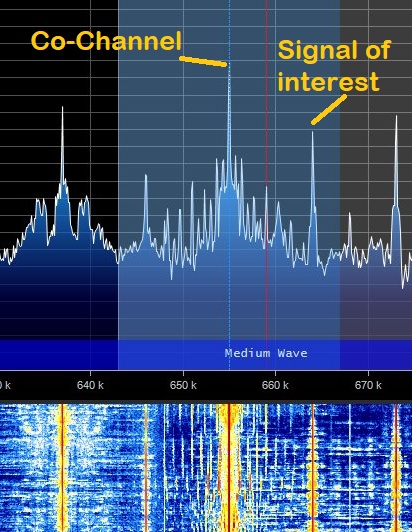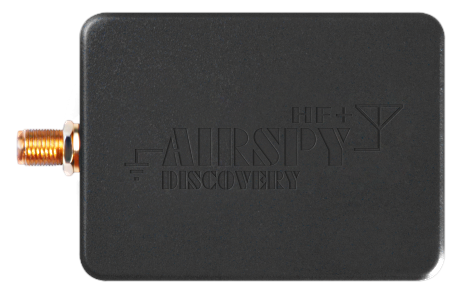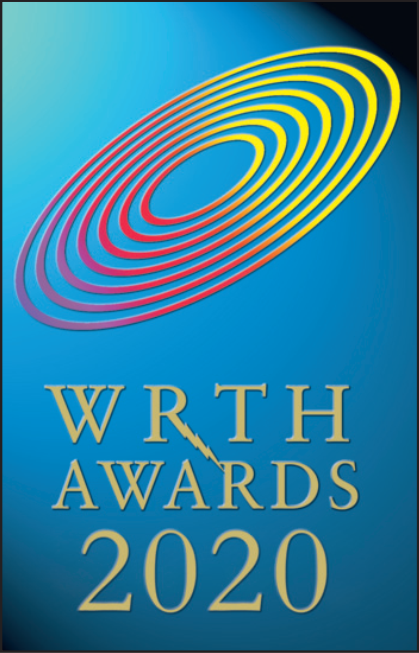Try our Award Winning HF/VHF Receiver!
Building on the field-proven Airspy HF+ architecture, we designed the Most Refined HF/VHF SDR with world class performance in the smallest form factor.
The Airspy HF+ Discovery sets a new standard in terms of reception performance with extra pre-selectors for all the supported bands and a New DSP Core to optimize the gain distribution and the filtering parameters in real-time and dig deeper in the noise.
The signal path includes very high dynamic range data converters along with high performance passive mixers with an excellent Polyphase Harmonic Rejection structure. The included band-tracking pre-selectors eliminate unwanted interference and preserve the dynamic range of the receiver. With its world class strong signal handling capability and incredibly Low Noise, the HF+ Discovery is the ideal companion for All your High Performance Receive Scenarios.
Both the architecture and level of integration achieved in this design allow us to bring top performance reception at a very affordable price.
All the major SDR software is supported. Check the download page.
Ready to discover all these signals hiding in your spectrum?
What’s more, the Airspy HF+ Discovery won the Prestigious WRTH Award in 2020 in front of a fierce competition of highly refined communication receivers.
It seems it will be hard to beat our own performance here. Time will tell.
Ground Breaking Co-Channel Processing Capability
Our customers matter a lot for us. They are our friends, colleagues and we are a big family. Following the requests to spend some time on enhancing Medium Waves and Short Waves AM DX reception in presence of Co-Channel interference, we developed the world’s first working Co-Channel Canceller algorithm, for the benefit for all the existing Airspy users. This patent-pending algorithm not only recovers the interference plagued audio, but can also be combined with our other plugins to fight QRM, QRN, and anything that could compromise your signals. This feature is unique.
Check these two demos from the crowded Japanese MW spectrum with very strong local blockers:
This even works with Zero-Offset Co-Channel, ie. You can remove the local station and listen to the DX stations at the same frequency. This is the AM DXer’s dream come true. This demo from the Netherlands shows a very strong local station with distorted phase being cancelled completely to unbury some very weak stations in Europe:


Unrivalled Noise Reduction Processing
We spent a lot of time understanding RF noise, its structure, and how it interacts with legitimate signals. Today, we have one of the most flexible and acoustically pleasant noise reduction algorithms of the market. The applications range from high-fidelity hiss removal for Broadcast FM signals, to unburying weak SSB signals from the noise floor. Our algorithm doesn’t kill the highs to give you a false impression of loudness, yet it doesn’t have the typical high tone artifacts that plague popular noise reduction algorithms like LMS and Spectral Subtraction.
Here’s a very weak SSB signal in the 40m band, with and without our Digital Noise Reduction. Check by yourself in this crowded Japanese MW grab!
Another recording in the 80m during a pileup:
Audio signal without processing:

Audio signal with our Digital Noise Reduction processing:

State of the Art Front-End Technology
The Airspy HF+ Discovery boasts one of the most sophisticated HF front-end of the market with multiple AGC loops at different stages to achieve the best gain distribution possible. There are many AGCs at different levels:
Analog:
- RF AGC, which activates a 6dB stepped attenuator,
- Analog IF AGC, which controls the IF gain just before the digitization.
Digital:
- Digital IF AGC, to make sure the data is scaled properly (by digital amplification) before sending to the computer,
- Narrow band AGC, which is the AGC panel controlling the signal that passes through the VFO filter.
Important Notes:
- The role of the Analog AGCs is to adapt the sensitivity of the front-end to the signals at the input. When enabling the AGC in the Source panel, you are activating both Analog AGCs.
- The Digital IF AGC is always activated and only starts acting when the strongest signal(s) in the IF spectrum exceed -6 dBFS. This mechanism ensures your signals are always scaled properly for unattended operations.
- When turning the Analog AGCs off, you can control the stepped attenuator manually, but then, it’s up to you to determine which attenuation level is adequate for your signal at input. In general, push the attenuation until the noise floor is around -100 dBFS. Higher levels do not necessarily improve your SNR but will definitely reduce your available dynamic range. If in doubt, turn the AGC on and let it do the job.
- When turning the Analog AGC on, you will notice that you also have a “Threshold” option available. It is used to instruct the AGC to tolerate an extra 3 dB of signal power before setting the next attenuation level. “Threshold Low” means the front-end is “less sensitive”, and “Threshold High” means “more sensitive”. This is really useful when chasing marginal signals in presence of very strong blockers (~ 100 dB of difference).
- The preamp option, might be misleading, and should be probably renamed “postamp.” It has the same effect on the noise figure and the linearity as a preamp, but acts on the back-end (ADC + Digital/DSP post processing) of the receiver instead. Basically, turn the “preamp” option off to get an extra 12 dB of dynamic range by scrapping the quantization noise margin.
State of the Art SDR streaming technology!
We concentrated state of the art DSP and networking techniques into our SpyServer software to allow multiple users to stream high quality IQ data from the same receiver at the same time. No compromises in the quality were made like it is usually done in Web SDR interfaces. You get actual IQ data you can process with your plugins and extract the last bit of information out of it.
The server software is highly scalable and can run on computers as small as the $7 Orange Pi Zero to top end 64bit servers with multiple cores/cpus, including the popular Raspberry Pi series.

New Architecture Concept

HF Tuner
Airspy HF+ Discovery achieves excellent HF performance by means of a low-loss preselection filter, high linearity LNA, high linearity tunable RF filter, a polyphase harmonic rejection (HR) mixer that rejects up to the 21st harmonic and multi-stage analog and digital IF filtering.
The 6 dB-stepped AGC gain is fully controlled by the software running in the DSP which optimizes the gain distribution in real time for optimal sensitivity and linearity. Harmonic rejection is a key issue in wide band HF receivers because of the large input signal bandwidth of the input signal. The output of the IF-filter is then digitalized by a high dynamic range sigma delta IF ADC for further signal processing in the digital domain.
VHF Tuners
Excellent FM performance is also achieved by using optimized signal paths composed of band filters, high linearity LNAs with a stepped AGC, a polyphase harmonic rejection mixer and IF filters optimized for the FM broadcast bands.
The amplifier gain is switchable in 3 dB-steps and fully controlled by the AGC running in the DSP. The RF signal is converted to baseband by a high linearity passive mixer with a polyphase harmonic rejection structure. The low-IF signal is then converted into the digital domain by the same IF ADC used in the HF chain.
Extended VHF coverage is assured by a second Band-III tuner up to 260 MHz, but with reduced performance.
IF Sampling
The IF analog to digital converter (ADC) is a 4th order multi-bit noise shaping topology; it features very high dynamic range and linearity. The IF-ADC sampling rate is determined by a control algorithm running in the embedded DSP. This advanced technique adjusts the sampling rate depending on the tuning frequency with the goal of avoiding the disturbances and spurs generated by the switching discrete-time sections of the IF-ADC.
Digital Down Converter
Once the IF signal is digitalized, the high sample rate I/Q stream is then frequency translated and processed with cascaded CIC and FIR decimation stages. After every stage, the sample rate is reduced and the resolution increased. The final signal at the output has 18bit resolution and an alias rejection performance of 108 dBc. The data is then scaled to 16bit and sent to the Micro-Controller for streaming over USB.
Architectural Advantages
The main advantages over techniques from the legacy super-heterodynes up to the now mainstream direct sampling is that the whole receiver chain is well protected against out of band blockers while still relaxing the RF filtering constraints, making it simple and cost effective.
The natural filtering of the sigma-delta ADC combined with the excellent linearity and sensitivity of the analog chain reaches an unprecedented level of performance and integration.
Use it over the network!
Connect as many SDR applications as needed to the HF+ Discovery, over the Internet or in your own local network with near zero latency thanks to the new SPY Server software.
This setup basically brings all the flexibility of Web based SDRs while still benefiting from the full power of desktop applications. The IQ data is processed in the server with state of the art DSP and only the required chunk of spectrum is sent over the network. What is sent is the actual IQ signal, not compressed audio. This means you can use all your favorite plugins to process the IF, eliminate noise and perform heavy lifting of the signals as you are used to do with locally connected SDR’s.
We have a tradition of building multi-tools, so we made sure the SPY Server runs on 32/64bit Windows and Linux on Intel and ARM processors without any compromises. Low cost Raspberry Pi 3 and Odroid boards are in the party.
Technical specifications
- HF coverage between 0.5 kHz .. 31 MHz
- VHF coverage between 64 .. 260 MHz
- Sensitivity: -140.0 dBm (0.02 µV / 50 ohms at 15MHz) MDS Typ. at 500Hz bandwidth in HF
- Sensitivity: -141.5 dBm MDS Typ. at 500 Hz bandwidth in FM Broadcast Band (64 – 118 MHz)
- Sensitivity: -141.0 dBm MDS Typ. at 500 Hz bandwidth in VHF Aviation Band (118 – 260 MHz)
- Linearity: +15 dBm IIP3 on HF at maximum gain
- Linearity: +13 dBm IIP3 on VHF at maximum gain
- Dynamic Range: 110 dB blocking dynamic range (BDR) in HF
- Dynamic Range: 95 dB blocking dynamic range (BDR) in VHF
- Selectivity: 150+ dB combined selectivity (hardware + software)
- Image Rejection: 120 dB (software)
- Filtering: Polyphase Tracking filters for close range interference suppression
- Filtering: New High Performance Pre-selector for HF with 4 filter banks (corners at ~DC, 5, 10, 17 and 31 MHz)
- Filtering: New High Performance Pre-selector for VHF (Air, HAM, Commercial and Military VHF)
- Filtering: New High Performance Pre-selector for the FM band (Japan, US, EU, OIRT)
- Up to 660 kHz alias and image free output for 768 ksps IQ
- 18 bit Embedded Digital Down Converter (DDC)
- 22 bit Resolution at 3 kHz channel using State of the Art DDC (SDR# and SDR-Console)
- +10 dBm Maximum RF input
- 0.5 ppm high precision, low phase noise clock
- 1 PPB frequency adjustment capability
- Very low phase noise PLL (-110 dBc/Hz @ 1kHz separation @ 100 MHz)
- Best Noise reduction of the market using state of the art algorithms
- 2 x High Dynamic Range Sigma Delta ADCs @ up to 36 MSPS
- Single RF Input to cover all bands with High Linearity switching
- Improved input matching down to virtually DC
- Smart AGC with real time optimization of the gain distribution for Best SNR in all situations
- No drivers required! 100% Plug-and-play on Windows Vista, Seven, 8, 8.1 and 10
- Industrial Operating Temperature: -45°C to 85°C
- Ultra small Form Factor: 45 x 60 x 10 mm
Typical Applications
- SIGINT/COMINT
- High Performance HF/VHF Telemetry
- Spectrum Analyzer
- Ham Radio (HF + 2m)
- Short Wave Listening (SWL)
- AM/FM/TV DX
- Long Range IoT
Supported Software
- The gold standard SDR#
- The ultimate Narrowband Signals Analysis and Decoding Suite Krypto500
- The ultimate Wideband Signals Analysis and Decoding Suite Krypto1000
- The other excellent SDR suite, SDR-Console
- The Suiss-army SDR knife for Linux and Mac, GQRX
- Network server for use with SdrDx for Mac, AirspyHF+ Mac Server
- All ExtIO based software (HDSDR, Studio1, etc.) via ExtIO by Hayati Ayguen
- All ExtIO based software (HDSDR, Studio1, etc.) via ExtIO by Andrea Montefusco
- Check the full list of tools in our download page
Supported Operating Systems
- Windows 10 and 11
- Linux
- BSD
- Mac
Supported Hardware
- Intel compatible PC
- Raspberry Pi 2 and up
- Many other Single Board Computers (SBC)
Minimum hardware requirements
- 1GHz Pentium or ARM
- 1GB of RAM (to run your own OS, HF+ barely needs 1MB of memory)
- High speed USB 2.0 controller
Fully Open-Source driver
- Open source, multi-platform user mode driver libairspyhf on github
Firmware Updates
- Change log
- Latest Stable R5.0.1 2024-12-11


